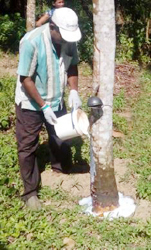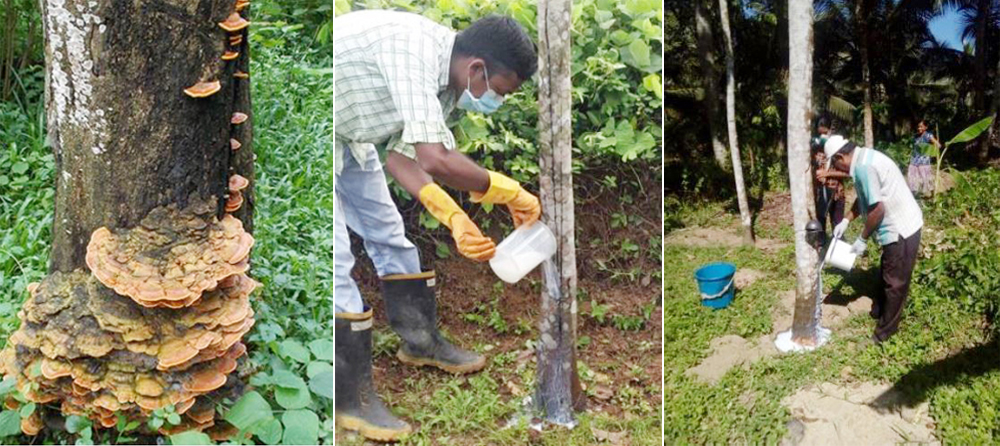Plant Pathology & Microbiology Department




Mission
To be the Centre for excellence in planning, implementation and management of research on all aspects of the maladies of the rubber plantations, improvement of beneficial soil microbiology and other microbiological applications in the most economical and environmentally sustainable manner.
Main research projects include screening of clones for disease resistance, screening of pesticides, development of integrated pest management systems, studying the biology and epidemiology of pests and surveillance of potential pathogens & disease out breaks, biological control of Hevea pests, improvement of beneficial soil microflora and related microbiological studies. And also the studies on the biology & molecular biological research on plant pathogens. The department undertakes training programmes on the identification and management of all the rubber diseases.

Head, Plant Pathology & Microbiology Department
Mrs T H P S Fernando, BSc (SL), MPhil (SL), PhD (SL)
Responsible in planning, implementation and monitoring of research projects on rubber pest & maladies of national interest and beneficial soil microbiological aspects. Obtained the BSc Degree (Biological Science) in 1996 and later in the year 2000, obtained the MPhill degree in Plant Pathology from the University of Colombo, Sri Lanka. Has completed the PhD from the same University on the Corynespora leaf fall disease of rubber. Have published over 60 scientific publications & was honored by the GRC Post Graduate Award 2013 by the SLASS, Award for Excellence in Scientific Research 2011 by the YSF NASTEC, Ministry of Technology & Research and seven President's Research Awards for the effective contribution made to the reputation of the country. A member of several national level committees: National Plant Protection Commette - CARP, Pesticide Technical & Advisory Committee (PeTAC) and the Pesticide sub-commette. Has received research grants from the National Research Council (NRC), National Science Foundation (NSF) & International Foundation for Science (IFS), Stockholm, Sweden.

Senior Research Officer
Mrs M K R Silva, BSc Agric (SL), MSc (SL), PhD (SL)
Obtained a B.Sc. degree in Agriculture (Special) with a First Class (Honours) from University of Ruhuna (2005) and a M.Sc. degree in Molecular and Applied Microbiology from University of Peradeniya (2008). Has completed the PhD from the University of Colombo on the brown root disease of rubber. Joined RRISL in the year 2011. Joined RRISL in the year 2011 and currently reading for the Ph.D. from the University of Colombo. Has almost twelve years working experience in the field of Plant Pathology & Microbiology and currently, responsible in initiating, designing and carrying out of research projects on the pest and disease aspects of the rubber plantations.
.jpg)
Research Officer
Mrs H V A Shehani Koshila, BSc (SL), MPhil (SL)
H. V. A. Shehani Koshila obtained her B.Sc. (Honours) degree from the University of Ruhuna in 2017 and her MPhil degree in Biological Sciences from the University of Kelaniya in 2022. She received the Postgraduate Research Merit Award in 2023 from the Sri Lanka Association for the Advancement of Science (SLASS) in recognition of her contributions to postgraduate research in Agricultural Science. She is currently involved in research on the maladies affecting rubber plantations and microbiological aspects for the improvement of rubber cultivation in the country.
- T.H.P.S. Fernando- Award 1 – Year 2001 - Mycopathologia 152: 97-101. For the world’s first record of the toxic metabolite produced by Colletotrichum acutatum.
- T.H.P.S. Fernando- Award 2 – Year 2001 - Mycological Research 105: 195 – 201. For the world’s first record of the cell wall degrading enzymes produced by Colletotrichum acutatum.
- T.H.P.S. Fernando- Award 3 – Year 2000 - Mycological Research, 104: 518 – 685. For finding out the factors affecting spore production, germination and viability of Colletotrichum acutatum from Hevea brasiliensis.
- T.H.P.S. Fernando- Award 4 – Year 1999 - Mycopathologia, 143: 93 -95. For innovation of an internationally accepted simple and reliable technique for the identification of two Colletotrichum species causing Colletotrichum leaf disease of rubber.
- T.H.P.S. Fernando- Award 5 – Year 2004 - Mycopathologia, 157: 73 - 79. For the world’s first record of the cell wall degrading enzymes produced by Thanatephorus cucumeris.
- T.H.P.S. Fernando- Award 6 – Year 2004 - Mycopathologia, 157: 81 - 85. For the first record of (Flacourtiainermis) as an alternative host for Colletotrichum acutatum.
- T.H.P.S. Fernando- Best oral presentation in the Rubber Sector, 2nd Plantation Crops Symposium - 2008.
- T.H.P.S. Fernando- Award for Excellence in Scientific Research – 2011” by the Young Scientists Forum – National Science and Technology Commission, Ministry of Technology & Research.
- T.H.P.S. Fernando- “GRC Post Graduate Award 2012– Merit Award” by the Sri Lanka Association for the Advancement of Science (SLASS).
- T.H.P.S. Fernando- Merit Certificate: for the Oral Presentation on the “Screening of clones against Corynespora Leaf Fall Diseases of Hevea brasiliensis” at the YSF Symposium 2012 held on 18th January 2013, by National Science and Technology Commission, Ministry of Technology & Research.
- T.H.P.S. Fernando- Best Researcher Award – Rubber Sector for 2014 – 2015 at the Plantation Crop Symposium, 2016.
- M.K.R. Silva - Second runner-up for the Outstanding Research Project in the 7th Annual Graduate Research Seminar – 2006, Faculty of Agriculture, University of Ruhuna.
- M.K.R. Silva - Meritorious Awards: DHE Mohotti Memorial Gold Medal for the Best Performance in Farm Practice Course (2004).
.JPG)






- White root disease surveying programme.
- Conduct training programmes on Identification of economically important diseases of rubber. (Leaf Diseases / Stem, branch and panel diseases / Root diseases)
- Conduct training programmes on the Management of economically important diseases.
- Conduct training programmes on the identification and the management of nursery diseases.
- Advising the stakeholders to identify and manage diseases of rubber.
- Providing microbiological reports on rubber related products.
- Providing sample testings for the pathogens of quarantine importance.
REVISED TESTING CHARGES – July 2022
Testing charges have been revised with effect from 01.07.2022, as mentioned in the following table.
Note: Please note that Transport charges, Priority charges & Institutional charges have not been added to the toal charges. It should be added to the total charges whenever necessary. Figuers are in LKR.
|
Name of the Test
|
Testing Fee (Rs.) |
|
|
1 |
Identification of a diseased sample – up to genus level of the causative agent |
5100 |
|
2 |
Soil microbiological Test |
5100 |
|
3 |
Product microbiological Test |
5100 |
|
4 |
Quarantine test |
5100 |
|
5 |
Microbiological testing for Compost |
5100 |
|
6 |
Bioefficacy test (pesticide / biopesticide) |
50,000 |
|
7 |
Purchasing microbiological cultures |
5100 |
- Fernando THPS, Jayasinghe CK, Wijesundera RLC and Siriwardane D (2012) Some factors affecting in vitro production, germination and viability of conidia of Corynespora cassiicola from Hevea brasiliensis. Journal of the National Science Foundation. 40: 241-249
- Fernando THPS, Jayasinghe CK, Wijesundera RLC and Siriwardane D (2010) Screening of fungicides against Corynespora leaf fall disease of rubber under nursery conditions. Journal of Plant Diseases and Protection.117 (3):, 117-121, 2010, ISSN 1861-3829.
- Fernando THPS, Jayasinghe CK, Wijesundera RLC and Siriwardane D (2009) Variability of Heveaisolates of Corynespora cassiicola from Sri Lanka. Journal of Plant Diseases and Protection, 116 (3): 115-117, 2009, ISSN 1861-3829.
- Fernando THPS, Jayasinghe CK, Wijesundera RLC, Silva WPK&Nishantha N (2009) Evaluation of screening methods against Corynespora leaf fall disease of rubber (Hevea brasiliensis). Journal of Plant Diseases and Protection. 117 (1): 24-29, 2010, ISSN 1861-3829.
- Jayasinghe CK &Fernando THPS (2004) Re-identification and characterization of pathogens causing ugurassa (Flacoutia inermis) fruit anthracnose. Mycopathologia, 157: 81-85.
- Jayasinghe CK, Wijeratne, S.C.P. &Fernando THPS (2004). Characterization of cell wall degrading enzymes of Thanatephorus cucumeris. Mycopathologia, 157: 73-79.
- Fernando THPS, Jayasinghe CK &Wijesundera RLC (2001) Cell wall degrading enzyme secretion by Colletotrchum acutatum, the causative fungus of secondary leaf fall of Hevea brasiliensis (rubber). Mycological Research, 105 (2);195-201.
- Fernando THPS, Jayasinghe CK &Wijesundera RLC (2000) Factors affecting spore production, germination and viability of Colletotrichum acutatum isolates from Hevea brasiliensis. Mycological Research, 104: 681-685.
- Jayasinghe CK & Fernando THPS (2000). Toxic activity from liquid culture of Colletotrichum acutatum. Mycopathologia 152: 97-101.
- Fernando THPS, Madushani HKI., Wijesundera RLC & Siriwardena D (2013) First Report of White Root disease of Artocarpus nobilis in Sri Lanka caused by Rigidoporus microporus. Journal of the National Science Foundation. 42(2): 197-198
- Silva, M.K.R., Samarajeewa, P.K. and Senanayake, S.J.G.N., (2007). Microsatellite Marker Technique as a Molecular-aided Selection Tool in Rice (Oryza sativa) Breeding for Thrips (Stenchetothrips biformis) Resistance. Fourth Academic Sessions, University of Ruhuna, Matara, Sri Lanka.
- Silva, M.K.R., Jayasinghe,C.K. and Tennakoon, B.I., (2014). Evaluation of the antagonistic effect of different plant species on White Root Disease causing fungus: Rigidoporus microporus. Fifth Symposium on Plantation Crop Research, Sri Lanka.
- Silva, M.K.R., Abeysekera, A.S.K., Nugaliyadde, L. and Udayanga, D.G.E., (2008). An assessment of weedy-rice seed density in paddy soils in the Southern Sri Lanka. National Symposium, Faculty Of Agriculture, University of Ruhuna, Matara, Sri Lanka.
- Darshana, K.V.W.S., Silva, M.K.R., Abeysekera, A.S.K. and Nugaliyadde, L., (2007). Weedy Rice in Southern Sri Lanka: Abundance, Diversity and Farmer Awareness. 21stAsia Pacific Weed Science Conference, Colombo, Sri Lanka.
- Gunarathne, L.H.S.N., and Fernando, T.H.P.S. 2017. The potential use of plant growth promoting rhizobacteria( PGPR) as antagonists and biocontrol agents in Hevea diseases. Proceedings of the International Forestry and Environment Symposium. 22: 17.
- Gunarathne, L.H.S.N., and De Costa, D.M. 2013. Investigations on the Causes of Rice Grain Discoloration in Sri Lanka. Sri Lankan Journal of Agriculture.38: 233-239
- Gunarathne, L.H.S.N., De Costa, D.M., and Dissanayake, D.M.N. 2013. Investigations on the Causes of Rice Grain Discoloration. PURSE.17: 165.






 Call 1919
Call 1919